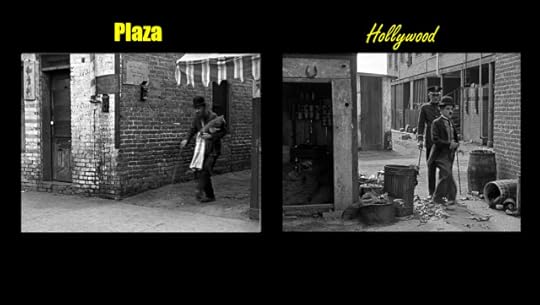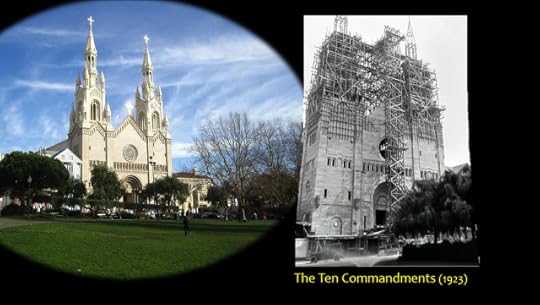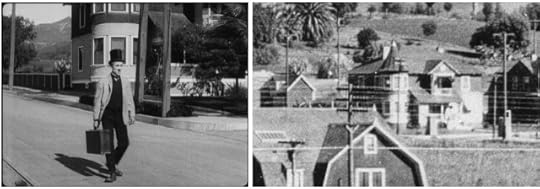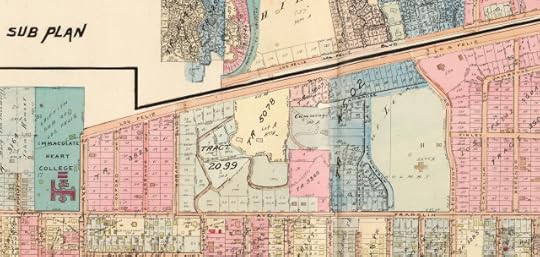John Bengtson's Blog, page 7
June 19, 2021
The Kid – Silent Footsteps a Century Ago – Niles Essanay Silent Film Museum Chaplin Days
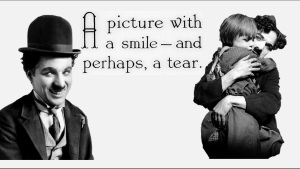 As part of the 2021 Chaplin Days hosted June 25-27 online by the Niles Essanay Silent Film Museum, I will be presenting an all-new video tour of the locations and incredible visual history hidden in the background of Charlie Chaplin’s now century-old masterpiece The Kid.
As part of the 2021 Chaplin Days hosted June 25-27 online by the Niles Essanay Silent Film Museum, I will be presenting an all-new video tour of the locations and incredible visual history hidden in the background of Charlie Chaplin’s now century-old masterpiece The Kid.
I am really pleased with how this turned out, highlighting many new details and discoveries not previously reported.
Like a busy ping-pong game, early in the film the action repeatedly cuts back and forth between downtown near the Plaza, and Hollywood. My talk clearly explains each cut and transition. Who knew the production was this complicated?
Above, behind the unique triangular building once standing on Ducommun Street, as it appears in Buster Keaton’s Cops (1922), was the starting point for Charlie’s highly cinematic rooftop chase during The Kid.
During Chaplin’s fight aboard the orphanage truck, they speed around an early working-class street corner east of downtown. Neither street survives today.
Overlapping locations along Wilshire Blvd., from A Film Johnnie (1914) and The Kid.
I had fun putting this The Kid – Silent Footsteps from a Century Ago show together, and hope you will check it out, along with the many other special programs and talks to be presented without charge as part of the Niles Essanay Silent Film Museum Chaplin Days event.
Until then, check out my YouTube talk from last year’s Chaplin Days.
The Kid and all images from Chaplin films made after 1918 Copyright © Roy Export S.A.S.
June 7, 2021
Silent Footsteps Now Online – SFSFF Amazing Tales
My Silent Footsteps Zoom webinar hosted by the San Francisco Silent Film Festival is now available for free online viewing at the festival’s online screening room.
An all-new program, my talk covers in part the hidden interplay between movies filmed in Hollywood and in San Francisco. Above, this landmark church facing San Francisco’s Washington Square almost appeared during Buster Keaton’s Day Dreams (1922), but played a huge role the next year during Cecil B. DeMille’s The Ten Commandments (1923).
Working with film historian Russell Merritt, we uncovered surprising vestiges of many important locations from D. W. Griffith’s epic masterpiece Intolerance (1916), hidden for over a century. Above, the Governor’s stairway and home featured during the film remain intact, but at two separate locations (?) My talk explains all, the first “hybrid” location I’ve ever discovered.
Vivid background details revealed in the Blu-ray release of Safety Last! (1923) helped establish Harold Lloyd filmed many scenes not in downtown LA, but in the Heart of Hollywood.
In closing, Modern Times (1936) was the last major Hollywood production to feature a silent film star in a movie with no spoken dialog. As Charlie Chaplin and Pauline Goddard set off together, we witness perhaps the concluding shot of the entire silent film era. We can share this moment with them decades later because it was preserved on film.
I had fun putting this Silent Footsteps show together, and hope you will check it out at the SFSFF’s online screening room.
May 29, 2021
Silent Footsteps – SFSFF Amazing Tales Online
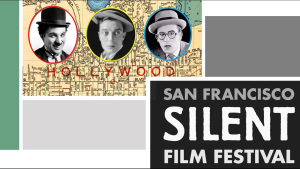 Hosted by the San Francisco Silent Film Festival, I will be presenting a Silent Footsteps Zoom webinar on Sunday, June 6 at 12:00 noon PST, as part of its ongoing Amazing Tales Online series. The webinar is free (register HERE), but SFSFF welcomes new members and support. The recorded presentation will be uploaded later to the festival’s online screening room.
Hosted by the San Francisco Silent Film Festival, I will be presenting a Silent Footsteps Zoom webinar on Sunday, June 6 at 12:00 noon PST, as part of its ongoing Amazing Tales Online series. The webinar is free (register HERE), but SFSFF welcomes new members and support. The recorded presentation will be uploaded later to the festival’s online screening room.
An all-new program, my talk covers in part the hidden interplay between movies filmed in Hollywood and in San Francisco. Buster Keaton filmed scenes adjacent to several San Francisco landmarks, but in each case before they were actually built!
Working with Biograph scholar Russell Merritt, we uncovered surprising vestiges of many important locations from D. W. Griffith’s epic masterpiece Intolerance (1916), hidden for over a century, that will be revealed for the first time during my talk. Above, a teaser of what we’ve discovered.
I’ll also reveal how a film unseen for decades, restored by SFSFF, provided the Rosetta Stone interconnecting various films that led to identifying the most consequential silent film location in all of Hollywood.
Fun details hide in the background of so many vintage Hollywood photos – above, the far-away set for Douglas Fairbanks’ The Thief of Bagdad (1924). I am especially pleased with how this program came together, and its many new surprises in store. I hope you can attend our Silent Footsteps Zoom webinar this Sunday, June 6 at 12:00 noon PST.
May 12, 2021
Worth a Thousand Words – Patrick Mate’s Chaplin-Keaton-Lloyd Alley Cartoon
Award-winning animator and wickedly funny caricaturist Patrick Mate has joined the campaign to name the Chaplin-Keaton-Lloyd Alley with this delightful cartoon, capturing the spirit of The Kid, Cops, and Safety Last! with a single image. A French-born DreamWorks Animation veteran and Smurf designer, worked recently illustrating filmmaker Daniel Raim’s documentaries Image Makers, chronicling pioneering cinematographers such as Gregg Toland, Rollie Totheroh, and James Wong Howe, and the acclaimed Harold and Lillian: A Hollywood Love Story, rated 97% “Fresh” on RottenTomatoes.
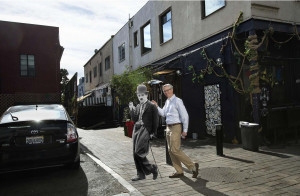
100 years apart – Mel Melcon – The Los Angeles Times
The alley has been in the news recently. First, City Beat columnist Nita Lelyveld wrote this compelling story for the Los Angeles Times.
Why Chaplin, Keaton and Lloyd deserve more Hollywood honor – Los Angeles Times (latimes.com)
Meanwhile, professor and writer Tyler Malone has this piece in Atlas Obscura.
The L.A. Alley That’s a Subtle Silent-Film Landmark – Atlas Obscura
As always, this video further explains the alley – if you can, please leave a thumbs up and share it with others.
April 30, 2021
Chaplin’s Bay Area Footsteps
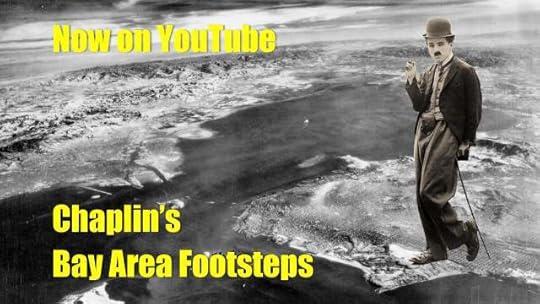 Hosted by the Niles Essanay Silent Film Museum, Charlie Chaplin leads us on a YouTube visual tour around the Bay Area, from San Francisco to San Jose, from Oakland to Niles itself.
Hosted by the Niles Essanay Silent Film Museum, Charlie Chaplin leads us on a YouTube visual tour around the Bay Area, from San Francisco to San Jose, from Oakland to Niles itself.
Chaplin’s meteoric career began with Mack Sennett’s Keystone Studio in 1914. When Charlie’s one-year contract was due to expire, he demanded his $150 weekly salary be raised to $1,000. Sennett balked, complaining this exceeded his own salary. Winning the resulting bidding war, the Essanay Studios signed Chaplin in November 1914 at $1,250 a week. After filming his first Essanay comedy in Chicago, during the dead of winter, Charlie fled the cold and repressive studio regime, and completed the remainder of his one-year contract in California.
Back in the Golden State, two Oakland settings near Lake Merritt, both still standing, appear during Charlie’s Bay Area debut movie A Night Out (1915).
Above, filming a car chase along the Great Highway in San Francisco during A Jitney Elopement (1915).
The tour even shows the iconic concluding scene to The Tramp (1915), where Charlie traipses down a lonely highway, ready for his next adventure.
The Chaplin Bay Area YouTube tour is free, but the Niles Essanay Silent Film Museum always welcomes support and new members.
Click the sign to watch the Chaplin-Keaton-Lloyd Alley video.
April 14, 2021
Charlie, Buster, and Harold Silent Footsteps LA Tour
Hosted by the Los Angeles City Historical Society, Charlie, Buster, and Harold will lead a silent footsteps tour across Bunker Hill, Chinatown, Olvera Street, and other historic downtown locations on Tuesday April 20 at 2 pm, to replayed later on YouTube. The webinar is free, but the Historical Society always welcomes support and new members.
The tour will take you step by step across early LA landscapes, many of which no longer exist. Above, a cop checks on Jackie Coogan during The Kid (1921), beside the former Tin How Mui Temple at Juan and Apablasa, once part of the original Chinatown, demolished to make way for Union Station.
Harold (left) in Ask Father (1919) and Buster (center) in Cops (1922) form a panoramic view looking west down New High Street from Temple. These grand early Civic Center buildings, and even the street, no longer exist.
From another era, Harold and Bebe Daniels in Lonesome Luke Messenger (1917) on the front lawn of the incredible Bradbury Mansion atop Court Hill, demolished in 1929.
Buster races south from down Arcadia from Main Street, past Sanchez Alley on the right, during Cops.
Please help support naming the Chaplin Keaton Lloyd alley in Hollywood by posting a review on Google Maps. Prototype alley sign design by noted Dutch graphic artist – Piet Schreuders. Download a 4-page brochure about the alley HERE. This video further explains the alley – if you can, please leave a thumbs up and share it with others.
March 24, 2021
Columbo and Mannix Save Us, Again
Comfort viewing classic-era TV shows during the pandemic has brought legions of new fans to Peter Falk’s Columbo. There’s something safe and reassuring about watching a humble and dedicated public servant do his duty, and bring wealthy, self-entitled criminals to justice. No one is above the law. I enjoyed the full series when it ran on Netflix a few years ago, and wrote a post about the overlap between Columbo filming locations and the silent era (above Chaplin in City Lights on Rodeo Drive in Beverly  Hills). Many Columbo episodes are now closer in time to the 1920s than to today. If you’re a fan, the Columbophile blogpost is also fun to visit.
Hills). Many Columbo episodes are now closer in time to the 1920s than to today. If you’re a fan, the Columbophile blogpost is also fun to visit.
My shelter-in-place security blanket this year has been rediscovering Mannix, the private-eye series I watched broadcast 50 years ago, but hadn’t seen since. The title character Joe Mannix, portrayed by Mike Connors, is nearly flawless. Tall, brave, athletic, wise, generous and kind, self-assured but never smug, gentle with kids, iron-fisted with thugs, and irresistible (yet respectful) with the ladies. While impossibly resourceful and resilient, Joe Mannix always gets the job done. Again, how reassuring is it to see someone honest and capable prevail time and time against evil?


It escaped my attention years ago, but the character Mannix (and actor Mike Connors) is of Armenian descent, who speaks Armenian and refers to Armenian proverbs during the show. This frame from the opening titles honors the Armenian flag. I had no idea.
I only watched a season or two when it first aired, but the jazzy, jaunty Mannix intro theme song, composed in 6/8 time by Lalo Schifrin (of Mission Impossible theme song fame), with the haunting piano middle bridge, is unforgettable. Becoming reacquainted with the song after five decades is a “remembrance of things past” that makes me smile (and even tear up) each time I crank up the volume to hear it play.



Another fun surprise is witnessing actors like Diane Keaton, Cloris Leachman, and Sally Kellerman make pre-fame appearances in early episodes. Likewise, Leave it to Beaver‘s father Hugh Beaumont appeared in three episodes, while The Brady Bunch dad Robert Reed, and Dr. Frank Burns from M*A*S*H, Larry Linville, played recurring roles as LA Police detectives who spar playfully with Joe.


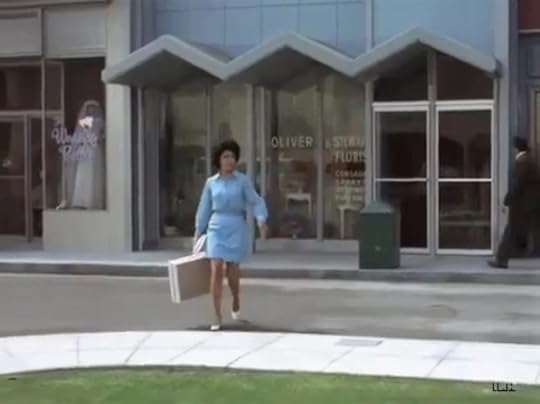
It’s also fascinating watching Joe drive around Los Angeles 50 years ago. I won’t discuss the locations, but I have to laugh how many times someone will turn right from Hollywood Blvd. and next appear on a remote stretch of Mulholland Drive miles away. While escaping my attention back then, the show filmed repeatedly at a modest and tiny Paramount backlot that today stands out unconvincingly like a sore thumb.
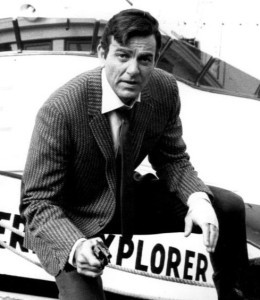 Truth be told, having watched about 20 episodes I may not delve much more deeply. The fistfights and car chases can be repetitive, and the premise has limitations – after all, how many renegade daughters of millionaires can Joe track down, how many noble city officials threatened by the mob can Joe rescue? But in these trying yet hopeful times, watching an honest, honorable, competent man reliably save the day is so comforting, and just what I need to see. The entire series appears to be available on YouTube – pick an episode at random and see what you think.
Truth be told, having watched about 20 episodes I may not delve much more deeply. The fistfights and car chases can be repetitive, and the premise has limitations – after all, how many renegade daughters of millionaires can Joe track down, how many noble city officials threatened by the mob can Joe rescue? But in these trying yet hopeful times, watching an honest, honorable, competent man reliably save the day is so comforting, and just what I need to see. The entire series appears to be available on YouTube – pick an episode at random and see what you think.
Please help support naming the Chaplin Keaton Lloyd alley in Hollywood by posting a review on Google Maps. Prototype alley sign design by noted Dutch graphic artist – Piet Schreuders. Download a 4-page brochure about the alley HERE. This video further explains the alley – if you can, please leave a thumbs up and share it with others.
March 16, 2021
Early Hollywood Visual Tour at HippFest 2021
Scotland’s HippFest Silent Film Festival starts tomorrow, Wednesday March 17 through Sunday March 21. Hosted virtually this year, the festival usually plays in Scotland’s oldest purpose-built cinema The Hippodrome in Bo’ness. The programs will be available through a new streaming platform called ‘INDY On Demand’ which allows you to enjoy the finest curated cinema from the comfort of your own home. You can purchase a INDY On Demand – HippFest pass HERE.
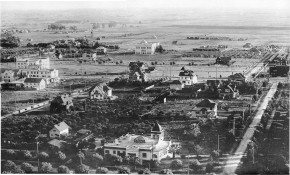
Hollywood 1905 – USC Digital Library.
The HippFest program includes a half hour visual tour I prepared showcasing the cinematic history hidden within early film and vintage Hollywood photos. For example, this 1905 Hollywood photo shows the hotel where Charlie Chaplin would film his first feature length comedy in 1914, the campus where Judy Garland would later attend high school, and the future sites for Sid Grauman’s Chinese Theater, and the Roosevelt Hotel, that would host the premiere Academy Awards ceremony.
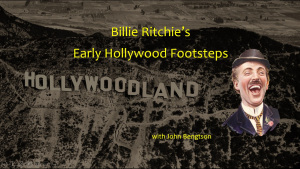 Entitled Billie Ritchie’s Early Hollywood Footsteps, my documentary includes rare film clips over a century old, featuring Mary Pickford and Scotland’s own slapstick hero Billie Ritchie, Charlie Chaplin’s main rival in 1915. I was pleasantly surprised to discover how richly Billie’s few surviving films illustrate Hollywood’s earliest days.
Entitled Billie Ritchie’s Early Hollywood Footsteps, my documentary includes rare film clips over a century old, featuring Mary Pickford and Scotland’s own slapstick hero Billie Ritchie, Charlie Chaplin’s main rival in 1915. I was pleasantly surprised to discover how richly Billie’s few surviving films illustrate Hollywood’s earliest days.

https://www.hippodromecinema.co.uk/media/4786/final-14-march-2021.pdf
This year the women of Hollywood are front and center, with Marlene Dietrich, Louise Brooks, and Mary Pickford all featuring in the star-studded program, featuring musicians from around the globe, and film introductions and post screening Q&As with noted film historians, along with a cook-along program, film quizzes, and even a chess contest to go along with the 1925 Moscow comedy Chess Fever. The festival closes with a restored screening of Mary Pickford’s Sparrows (1926). Here’s the full program above, and HippFest overview HERE.
Above, part of my program, Billie Ritchie in Father Was a Loafer (1915) at the corner of Western and Russell, with the same corner in 1906 (now a small strip mall). It was very satisfying putting this program together, and I hope you’ll consider supporting HippFest and watching my show, which begins streaming Sunday, March 21 at noon GMT (7:00 am PST). You can purchase Father Was a Loafer as part of Ben Model’s Undercrank Productions The Alice Howell Collection DVD release.
Please help support naming the Chaplin Keaton Lloyd alley in Hollywood by posting a review on Google Maps. Prototype alley sign design by noted Dutch graphic artist – Piet Schreuders. Download a 4-page brochure about the alley HERE. This video further explains the alley – if you can, please leave a thumbs up and share it with others.
March 6, 2021
Buster Keaton’s Early Days on Los Feliz
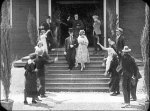 Straight from their opening-scene wedding in One Week (1920), staged on the steps of the Congregational Sunday School at the SE corner of Lillian Way and Romaine (kitty-corner from the Keaton Studio), Buster and Sybil Seely drive west along Los Feliz Blvd., a landmark Hollywood thoroughfare. Running east-west along the original southern border of Griffith Park, the open fields north of the dirt road were once populated with flower nurseries and hothouses, some visible during Sybil and Buster’s scene above.
Straight from their opening-scene wedding in One Week (1920), staged on the steps of the Congregational Sunday School at the SE corner of Lillian Way and Romaine (kitty-corner from the Keaton Studio), Buster and Sybil Seely drive west along Los Feliz Blvd., a landmark Hollywood thoroughfare. Running east-west along the original southern border of Griffith Park, the open fields north of the dirt road were once populated with flower nurseries and hothouses, some visible during Sybil and Buster’s scene above.

Click to enlarge – circa 1910 – looking east down rambling Los Feliz at the left. Franklin runs diagonally from lower right towards the center. Western Ave. runs from Immaculate Heart High School in the right foreground towards the right photo edge. This shows only half of the full panoramic photo. Huntington Digital Library.
Los Feliz terminates along its west end by turning south and merging into Western Avenue, a major north-south street and former trolley line. This west end appears in many opening scenes during One Week, and again in Buster’s Convict 13 (1920). I know little of the area’s rich history, but will focus on this circa 1910 panoramic view looking east down Los Feliz and south down Western in a single view.
To get our bearings, looking east, the red line marks Hobart Blvd. running south from Los Feliz (left) to Franklin (right). The low center hill is where Cecil B. DeMille would later build a grand estate. Note the prominent bunch of trees (yellow).
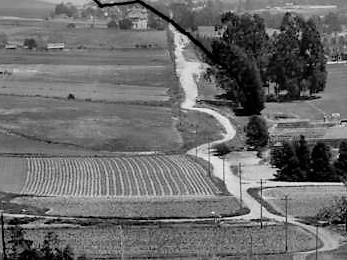

This closer view pairs with Buster astride two cars in One Week.

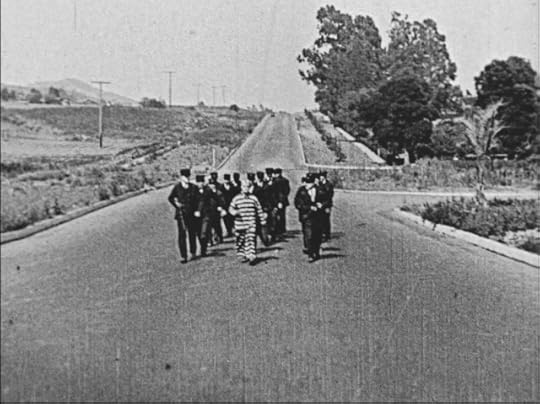
Next, matched with Convict 13, as they march from the near corner of Serrano Ave.



Notice the matching “Э” profile in the trees, along with a matching view from an unknown film clip studied by the Library of Congress “Mostly Lost” silent movie identification festival.
Again, here above is Hobart Ave. running south from Los Feliz at left to Franklin at right.


These views from One Week (left) and Convict 13 (right) look south down Hobart towards Franklin.


Matching views on Hobart from Convict 13 , looking south toward Franklin at left, and north from Franklin at right (notice the ridge line).


Matching views looking north from Los Feliz towards Griffith Park, with Convict 13 at left, and the Mostly Lost mystery film at right. Notice the distinctive ridge line over the comic’s top hat, matching the center of the left Convict 13 frame, and the Convict 13 frame further above.


The distinctive barn in the foreground appears during One Week as Buster attempts to hail a ride, looking west at where Los Feliz turns south to merge into Western. Note the prominent cement stairway.

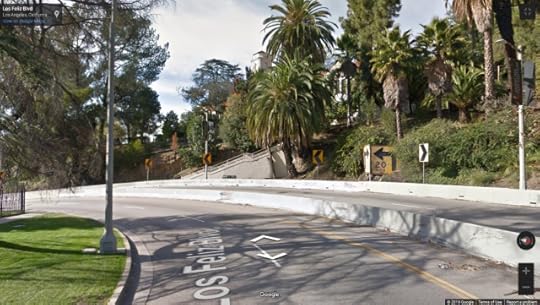
The barn is long gone – it stood on what is now the campus for the American Film Institute, but the stairway remains.


Again matching views from One Week (left) and Convict 13 (right) looking east on Los Feliz, showing the near corner of Serrano Ave.


Given the logistics and similar landscaping, these early scenes from One Week were likely filmed on Los Feliz as well.

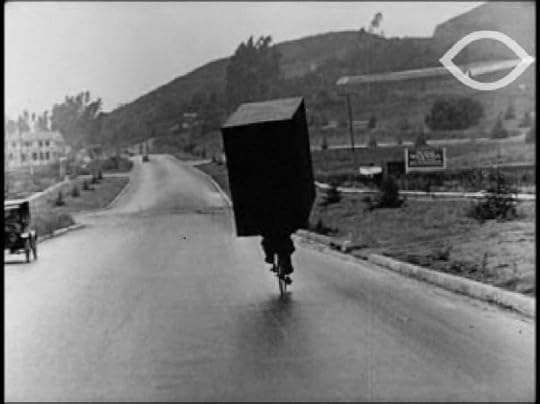
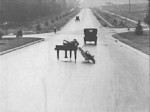 A popular filming site, Los Feliz appears, for example, in the Larry Semon – Stan Laurel comedy Frauds and Frenzies (1918) above left, and in Al St. John’s Out of Place (1922) above right, showing Immaculate Heart and the stairway at back. Snub Pollard rode a runaway grand piano here too during Sold at Auction (1923).
A popular filming site, Los Feliz appears, for example, in the Larry Semon – Stan Laurel comedy Frauds and Frenzies (1918) above left, and in Al St. John’s Out of Place (1922) above right, showing Immaculate Heart and the stairway at back. Snub Pollard rode a runaway grand piano here too during Sold at Auction (1923).
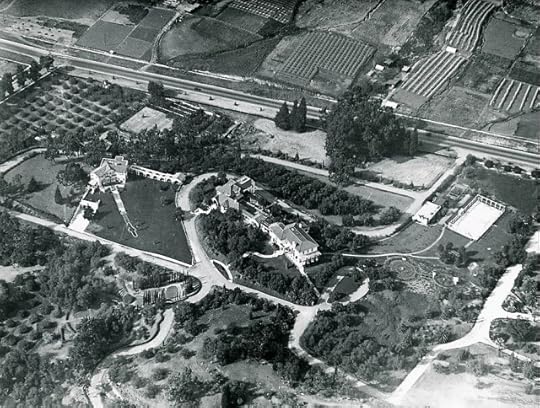

This 1921 aerial view of the Cecil B. DeMille estate, looking north, shows that prominent bunch of trees just south of Los Feliz, appearing again in Convict 13 (right), this time much further east, looking west toward that barn and stairway far at back. Hobart Blvd. appears at the left edge of the aerial view. HollywoodPhotographs.com.
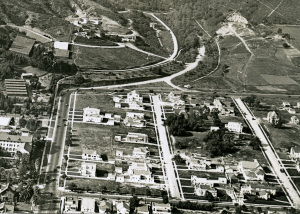 This 1920 Baist Atlas (page 41) provides an overview. While subdivided, nearly all the land between Los Feliz and Franklin are empty lots awaiting future homes. DeMille would build his house on that TR 5078. Looking north, this 1922 aerial shows the corner where Los Feliz turns into Western, with Immaculate Heart High School at the left. HollywoodPhotographs.com.
This 1920 Baist Atlas (page 41) provides an overview. While subdivided, nearly all the land between Los Feliz and Franklin are empty lots awaiting future homes. DeMille would build his house on that TR 5078. Looking north, this 1922 aerial shows the corner where Los Feliz turns into Western, with Immaculate Heart High School at the left. HollywoodPhotographs.com.


In closing, these now 20 year old (!) photos provide a sense of Los Feliz today. You can explore further on Google Maps below.
Please help support naming the Chaplin Keaton Lloyd alley in Hollywood by posting a review on Google Maps. Prototype alley sign design by noted Dutch graphic artist – Piet Schreuders. Download a 4-page brochure about the alley HERE. This video further explains the alley – if you can, please leave a thumbs up and share it with others.
Los Feliz today on Google Maps
February 6, 2021
Incredible new Laurel “OR” Hardy film collection
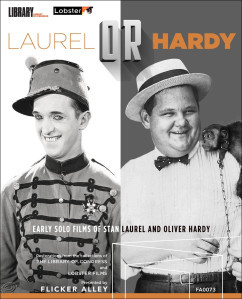 Flicker Alley’s exciting new Laurel OR Hardy Blu-ray release offers a wide collection of early films created by Stan Laurel or Oliver Hardy, but each as solo stars before being paired as the world’s most beloved comedy duo. Beautifully restored by Serge Bromberg’s Lobster Films, the set contains 17 short comedies featuring Stan, and 18 films with Ollie in the cast, along with program notes by film historian Rob Stone.
Flicker Alley’s exciting new Laurel OR Hardy Blu-ray release offers a wide collection of early films created by Stan Laurel or Oliver Hardy, but each as solo stars before being paired as the world’s most beloved comedy duo. Beautifully restored by Serge Bromberg’s Lobster Films, the set contains 17 short comedies featuring Stan, and 18 films with Ollie in the cast, along with program notes by film historian Rob Stone.
Quickly, here are two fun discoveries from the set, one for Stan, one for Ollie. The Boys are well-remembered for The Music Box (1932) inset, awarded the first Academy Award for Best Live Action Short, where they famously struggle to deliver a piano up a long flight of 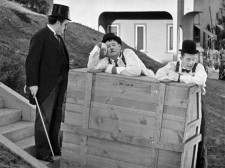 stairs. The film was inducted into the National Film Registry of the Library of Congress. Located between 923 and 935 N. Vendome Street, the historic site is well-documented, and is not only an international tourist attraction, but home to the annual Music Box Day celebration. The Boys also filmed their now lost silent comedy Hats Off (1927) attempting to carry a bulky washing machine up the same pesky stairs.
stairs. The film was inducted into the National Film Registry of the Library of Congress. Located between 923 and 935 N. Vendome Street, the historic site is well-documented, and is not only an international tourist attraction, but home to the annual Music Box Day celebration. The Boys also filmed their now lost silent comedy Hats Off (1927) attempting to carry a bulky washing machine up the same pesky stairs.

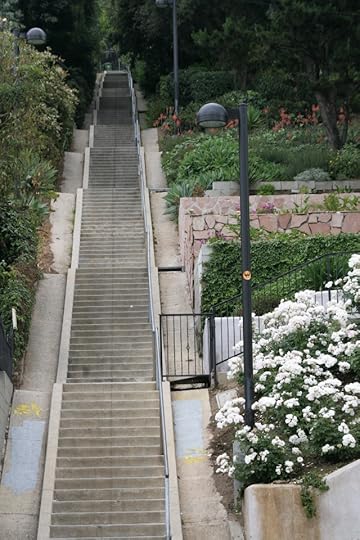
But years earlier Stan alone struggled with a different intimidating flight of stairs during The Pest (1922). The film is loaded with early Hollywood locations, but for now, here is the stairway, located at 2146 Cove Avenue, about 2 miles NE from The Music Box site (see map connecting both sites).
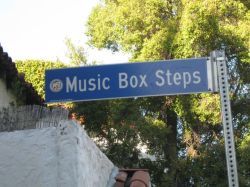 A public walkway, the City officially named the first stairway “Music Box Steps” to honor its cultural, historic, and movie tourism appeal. We hope the City will continue this tradition by naming an anonymous Hollywood alley, also a public walkway, the “Chaplin-Keaton-Lloyd Alley” (see more below), where these great stars filmed The Kid (1921), Cops (1922) and Safety Last! (1923), each a masterpiece also inducted into the National Film Registry. With little cost or effort the City can simply give it a name, akin to San Francisco naming its alleys and byways after famous resident authors.
A public walkway, the City officially named the first stairway “Music Box Steps” to honor its cultural, historic, and movie tourism appeal. We hope the City will continue this tradition by naming an anonymous Hollywood alley, also a public walkway, the “Chaplin-Keaton-Lloyd Alley” (see more below), where these great stars filmed The Kid (1921), Cops (1922) and Safety Last! (1923), each a masterpiece also inducted into the National Film Registry. With little cost or effort the City can simply give it a name, akin to San Francisco naming its alleys and byways after famous resident authors.
Which leads to Ollie’s location discovery. Yes, the Flicker Alley collection reveals Oliver Hardy also filmed at the Chaplin-Keaton-Lloyd Alley, chasing after Billy West in the 1925 comedy Rivals. Ollie’s scene is matched against the alley as it appears in the 1917 Lyons and Moran comedy What A Clue Will Do. The rickety wooden stairway was removed by 1922 (it does not appear during Buster’s scene from Cops), but numerous matching details confirm the site.
Bonus – Douglas Fairbanks filmed Flirting With Fate (1916) at the alley too. This makes perfect sense given he’s chased all around the alley site at Cahuenga and Cosmo during the film. The details from the Lyons and Moran frame confirm the match. So along with Chaplin, Keaton, and Lloyd’s masterpieces, Harry Houdini, Colleen Moore, Gale Henry, and now both Oliver Hardy and Douglas Fairbanks, all staged more modest films there as well. Given the alley’s frequent use, and proximity to various studios, I’m confident it appeared in numerous other silent films, now sadly lost to history.
Please help support naming the Chaplin Keaton Lloyd alley in Hollywood by posting a review on Google Maps. Prototype alley sign design by noted Dutch graphic artist – Piet Schreuders. Download a 4-page brochure about the alley HERE. This video further explains the alley – if you can, please leave a thumbs up and share it with others.
Flicker Alley – Laurel or Hardy: Early Films of Stan Laurel and Oliver Hardy
Below, the stairs at Cove Avenue appearing with Stan in The Pest a century ago.


